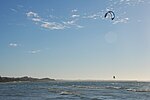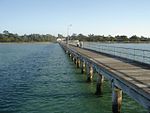Capel Sound, Victoria
Capel Sound is a suburb of Melbourne located on the Mornington Peninsula in Victoria, Australia. Its local government area is the Shire of Mornington Peninsula. At the 2016 Census, Capel Sound, then Rosebud West, had a population of 4,930.A distinguishing landmark feature of Capel Sound is the Tootgarook Swamp, the largest example left of a shallow freshwater marsh in the Port Phillip bay region. The swamp is also described by Melbourne water as a ground water dependent ecosystem. The 381 hectare swamp is found on the lower section of the Mornington Peninsula, called the Nepean Peninsula in Victoria, Australia. A large portion of the Tootgarook Swamp is zoned as residential and industrial, with roughly half of the actual swamp inside the green wedge and half within the urban growth boundary.
Excerpt from the Wikipedia article Capel Sound, Victoria (License: CC BY-SA 3.0, Authors).Capel Sound, Victoria
Elizabeth Avenue, Melbourne Capel Sound
Geographical coordinates (GPS) Address Nearby Places Show on map
Geographical coordinates (GPS)
| Latitude | Longitude |
|---|---|
| N -38.377 ° | E 144.872 ° |
Address
Elizabeth Avenue
Elizabeth Avenue
3940 Melbourne, Capel Sound
Victoria, Australia
Open on Google Maps






